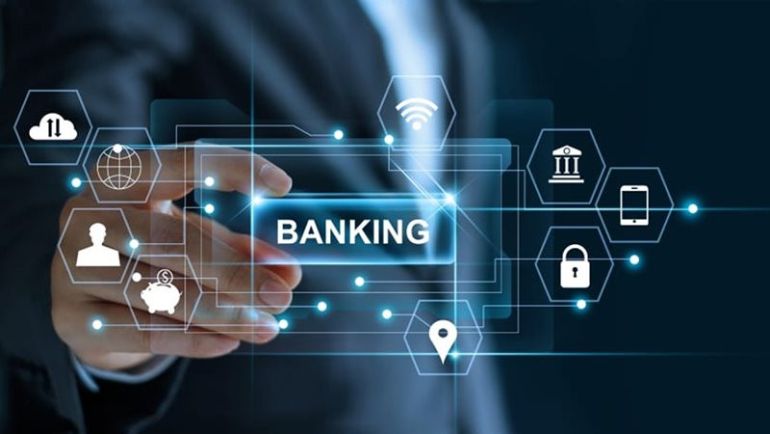Digital transformation in the banking sector: Achievements and new trends
- 134
- Digital
- 22:02 12/08/2024
DNHN - Digital transformation has become a dominant trend in the banking industry. Most banks have now adopted digital ecosystems, with over 90% of transactions being conducted through digital channels, contributing significantly to operational efficiency.
The banking sector has made remarkable strides in digital transformation, driven by the rapid development of digital technologies and IT applications. Banks have not only diversified their digital ecosystems but also integrated new products and services, bringing substantial benefits to both the banks and their customers. Current trends include the use of artificial intelligence (AI) to optimize processes and customer service, the deployment of comprehensive digital banking platforms, and the development of advanced security technologies. Banks are increasingly leveraging new technologies such as blockchain and big data analytics to enhance operational efficiency, improve customer experiences, and meet the growing demands of the digital financial market.
In recent years, digital transformation has become a robust trend in Vietnam's banking sector. Most banks have implemented diverse digital ecosystems, offering a wide range of digital products and services that significantly benefit both banks and customers. According to current data, many financial institutions in Vietnam have conducted over 90% of their transactions through digital channels. This transformation has not only increased operational efficiency but also contributed significantly to banks' profits in the first half of 2024.

Nam A Bank, a pioneer in digital transformation, has particularly focused on digitization and greening in its development strategy. The bank has integrated advanced technologies such as Open Banking, ONEBANK digital transaction points, and the OPBA Robot into its ecosystem. Additionally, it has launched initiatives to encourage cashless transactions, such as Market 4.0 and Tourism 4.0. These efforts have led Nam A Bank to achieve an impressive profit growth of over 45.4% in the first half of 2024, with its Open Banking product being recognized as a "Prominent Technology and Digital Transformation Product."
Similarly, MB Bank has achieved positive results thanks to its digital ecosystem development. According to the bank, the group's total assets increased by 5% compared to 2023, reaching VND 988,605 billion. MB's pre-tax profit reached VND 13,428 billion, up 5.4% year-on-year. With 97% of transactions conducted through digital channels, MB has risen to a leading position in Asia and topped the list of banks with the largest transaction volume through Napas for three consecutive years. The bank is expected to accelerate its digital transformation, aiming for 50-70% of its revenue to come from digital channels by 2026.
The successes of Nam A Bank and MB Bank demonstrate that digital transformation not only drives high business efficiency but also shapes the future of the banking industry. With these advancements, banks are gradually affirming their position and potential in the digital economy while better meeting customer needs in an increasingly digitized world.
In the first seven months of 2024, the State Bank of Vietnam (SBV) recorded positive progress in cashless payment and banking digital transformation. Key payment systems continued to operate stably and securely. As of now, more than 87% of adults in Vietnam have a bank account, with over 95% of transactions conducted through digital channels. The total number of cashless transactions reached 7.83 billion, up 58.23% in volume and 35.01% in value compared to the same period last year.
ABBANK has also actively enhanced customer experience through digital platforms and supported businesses in expanding their operations. The bank has implemented several strategic projects, such as the Omni Channel digital platform, Customer Relationship Management (CRM) system, and Datalake data management solution. The number of customers using ABBANK's digital banking and online transaction services saw impressive growth in the first half of 2024, increasing by 4.77% and 98.18%, respectively, compared to the same period last year.
According to SBV statistics, in the first half of 2024, cashless payment transactions increased by nearly 60% in volume and over 35% in value. Interbank electronic payment systems also witnessed an increase in the number and value of transactions. The banking industry continues to lead the digitalization trend, with electronic payment channels such as online and mobile banking, along with QR code payments, proving the effectiveness of this trend.
Phan Chinh
Related news
#digital payment

Digital transformation in the banking sector: The future direction of financial services
In the digital age, the banking industry needs to undergo digital transformation to drive development and improve customer experience. This transformation brings safety and efficiency while shaping the future direction of financial services.

Contactless payment services available at Petrolimex stations nationwide
The Vietnam National Petroleum Group (Petrolimex) cooperated with the global digital payment company Visa to launch contactless payment services at the former’s petrol stations across the country on May 31.
Đọc thêm Digital
Cybersecurity talent & digital entrepreneurs: Vietnam racing to fill a 700,000-person workforce gap
The “Student Cybersecurity Festival & Final Round of the 2025 Vietnam Cybersecurity Student Competition” (CSCV 2025), held on November 15 in Hanoi, became a major focal point for the technology community.
"Digital technicians" must not be forgotten if Vietnam aims to meet its strategic goals
Vietnam is facing a serious shortage of skilled technical operators. Without retaining its “digital technicians,” the ambition to become an AI hub may never materialize.
Prime Minister: Vietnam aims to become a regional logistics hub
At the 2025 FIATA World Congress in Hanoi, Prime Minister Pham Minh Chinh emphasized logistics as one of Vietnam’s key growth drivers, highlighting major infrastructure investments and commitments to attract global investors.
VietLeap AI Accelerator launches: A strategic springboard for Vietnam’s AI startups
The program is expected to select 10 to 15 high-growth potential AI startups with clear funding needs.
Vietnam advances cybersecurity law to boost digital sovereignty and business resilience
In a significant step towards strengthening Vietnam’s digital defenses, the National Assembly Standing Committee convened on September 23 to review the draft revised Cybersecurity Law.
Vietnam embraces digital tools to modernize public administration
Across Vietnam, local governments are turning to digital platforms, QR codes, and AI-powered assistants to modernize public services—making them faster, more transparent, and more accessible to citizens.
Administrative procedures for establishing the national technology exchange reduced to one application set
Deputy Prime Minister Nguyen Hoa Binh has just signed Decision No. 2108/QD-TTg approving the plan to streamline internal administrative procedures within the state administrative system under the management of the Ministry of Science and Technology.
Government’s plan to implement Law on Digital Technology Industry approved
The Government has approved a plan to implement the Law on Digital Technology Industry (the Law) scheduled to take effect from January 1, 2026, according to a report from the Government News.
Shark Nguyễn Hòa Bình: Hanoi will become the capital of startup innovation.
Recently, in Hanoi, the seminar “Formulating City People’s Council Resolutions to Promote Science and Technology Development in Connection with the Implementation of Politburo Resolution No. 57-NQ/TW and the Capital Law No. 39/2024/QH15” was held.
Da Nang proposes semiconductor cooperation with Oregon (USA)
Leaders of Da Nang City have proposed that Oregon (USA) and the city explore cooperation opportunities in priority sectors such as semiconductor technology, logistics, and the development of Free Trade Zone (FTZ) infrastructure.











